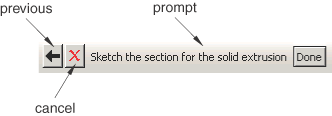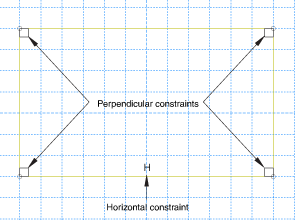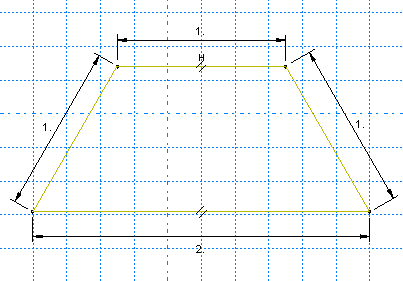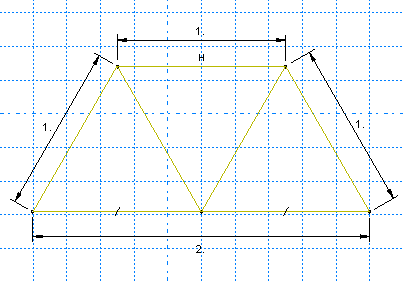Creating a part | ||
| ||
Context:
You will start the overhead hoist problem by creating a two-dimensional, deformable wire part. You do this by sketching the geometry of the frame. Abaqus/CAE automatically enters the Sketcher when you create a part.
Abaqus/CAE often displays a short message in the prompt area indicating what you should do next, as shown in Figure 1.

Click the Cancel button to cancel the current task. Click the Previous button to cancel the current step in the task and return to the previous step.
If you did not already start Abaqus/CAE, type abaqus cae, where abaqus is the command used to run Abaqus.
From the Create Model Database options in the Start Session dialog box that appears, select With Standard/Explicit Model.
Abaqus/CAE enters the Part module. The Model Tree appears in the left side of the main window (underneath the Model tab). Between the Model Tree and the canvas is the Part module toolbox. A toolbox contains a set of icons that allow expert users to bypass the menus in the main menu bar. For many tools, as you select an item from the main menu bar or the Model Tree, the corresponding tool is highlighted in the module toolbox so you can learn its location.
In the Model Tree, double-click the Parts container to create a new part.
The Create Part dialog box appears. Abaqus/CAE also displays text in the prompt area near the bottom of the window to guide you through the procedure.
You use the Create Part dialog box to name the part; to choose its modeling space, type, and base feature; and to set the approximate size. You can edit and rename a part after you create it; you can also change its modeling space and type but not its base feature.
Name the part Frame. Choose a two-dimensional planar deformable body and a wire base feature.
In the Approximate size text field, type 4.0.
The value entered in the Approximate size text field at the bottom of the dialog box sets the approximate size of the new part. The size that you enter is used by Abaqus/CAE to calculate the size of the Sketcher sheet and the spacing of its grid. You should choose this value to be on the order of the largest dimension of your finished part. Recall that Abaqus/CAE does not use specific units, but the units must be consistent throughout the model. In this model SI units will be used.
Click Continue to exit the Create Part dialog box.
Abaqus/CAE automatically enters the Sketcher. The Sketcher toolbox appears in the left side of the main window, and the Sketcher grid appears in the viewport. The Sketcher contains a set of basic tools that allow you to sketch the two-dimensional profile of your part. Abaqus/CAE enters the Sketcher whenever you create or edit a part. To finish using any tool, click mouse button 2 in the viewport or select a new tool.
Tip: Like all tools in Abaqus/CAE, if you simply position the cursor over a tool in the Sketcher toolbox for a short time, a small window appears that gives a brief description of the tool. When you select a tool, a white background appears on it. The following aspects of the Sketcher help you sketch the desired geometry:
-
The Sketcher grid helps you position the cursor and align objects in the viewport.
-
Dashed lines indicate the X- and Y-axes of the sketch and intersect at the origin of the sketch.
-
A triad in the lower-left corner of the viewport indicates the relationship between the sketch plane and the orientation of the part.
-
When you select a sketching tool, Abaqus/CAE displays the X- and Y-coordinates of the cursor in the upper-left corner of the viewport.
-
You will first sketch a rough approximation of the frame and later use constraints and dimensions to refine the sketch. Begin by using the Create Lines: Rectangle tool
 located in the upper-right region of the Sketcher toolbox to sketch an arbitrary rectangle. Select any two points as the opposite corners of the rectangle.
located in the upper-right region of the Sketcher toolbox to sketch an arbitrary rectangle. Select any two points as the opposite corners of the rectangle.Click mouse button 2 anywhere in the viewport to exit the rectangle tool.
Note:
If you make a mistake while using the Sketcher, you can undo your last action using the Undo tool
 or delete individual entities of your sketch using the Delete tool
or delete individual entities of your sketch using the Delete tool  .
.The Sketcher automatically adds constraints to the sketch as indicated in Figure 2 (in this case, the four corners of the rectangle are assigned perpendicular constraints and one edge is designated as horizontal).
Figure 2. Constraints indicated in the Sketcher.
To proceed, the perpendicular constraints must be deleted. In the Sketcher toolbox, select the Delete tool
 and then do the following:
and then do the following:- In the prompt area, select Constraints as the scope of the operation.
- Using ShiftClick, select the four perpendicular constraints.
- Click Done in the prompt area.
You will now add additional constraints and dimensions to refine the sketch. Constraints and dimensions allow you to control your sketch geometry and add precision. For more information on constraints and dimensions, see Controlling sketch geometry.
- Use the Add Constraint tool
 to constrain the top and bottom edges so they remain parallel to each other:
to constrain the top and bottom edges so they remain parallel to each other:In the Add Constraint dialog box, select Parallel.
In the viewport, select the top and bottom edges of the sketch (using ShiftClick).
Click Done in the prompt area.
- Use the Add Dimension tool
 to dimension the top and bottom edges of the rectangle. The top edge should have a horizontal dimension of 1 m and the bottom edge a horizontal dimension of 2 m. When dimensioning each edge, simply select the line, click mouse button 1 to position the dimension text, and then enter the new dimension in the prompt area. Selecting the line rather than its endpoints constrains the length of the line regardless of its orientation in space (in effect, defining an oblique dimension).
to dimension the top and bottom edges of the rectangle. The top edge should have a horizontal dimension of 1 m and the bottom edge a horizontal dimension of 2 m. When dimensioning each edge, simply select the line, click mouse button 1 to position the dimension text, and then enter the new dimension in the prompt area. Selecting the line rather than its endpoints constrains the length of the line regardless of its orientation in space (in effect, defining an oblique dimension).Reset the view as needed using the Auto-Fit View tool
 in the View Manipulation toolbar to see the updated sketch.
in the View Manipulation toolbar to see the updated sketch. - Dimension the left and right edges so they each have an oblique dimension of 1 m.
The sketch in its current state is shown in Figure 3. In this figure the default grid spacing has been doubled. For information on using the Sketcher Options tool
 to modify the Sketcher display, see Customizing the Sketcher.Figure 3. Rough sketch of frame (with grid spacing doubled).
to modify the Sketcher display, see Customizing the Sketcher.Figure 3. Rough sketch of frame (with grid spacing doubled).
- Use the Add Constraint tool
Now sketch the interior edges of the frame.
- Using the Create Lines: Connected tool
 located in the upper-right corner of the Sketcher toolbox, create two lines as follows:
located in the upper-right corner of the Sketcher toolbox, create two lines as follows:Start the first line at the upper-left corner of the sketch and extend it to any point that snaps onto the bottom edge (its horizontal location is arbitrary).
Continue the second line to the upper-right corner of the sketch.
Click mouse button 2 anywhere in the viewport to exit the connected lines tool.
- Using the Split tool
 , split the bottom edge at the point where it intersects the two lines created above:
, split the bottom edge at the point where it intersects the two lines created above:Note the small black triangles at the base of some of the toolbox icons. These triangles indicate the presence of hidden icons that can be revealed. Click and hold the Auto-Trim tool
 located on the middle-right of the Sketcher toolbox until additional icons appear.
located on the middle-right of the Sketcher toolbox until additional icons appear.From the set of additional icons, click the Split tool
 .
.The split tool appears in the Sketcher toolbox with a white background indicating that you selected it.
Select the bottom edge as the first entity to define the split point.
Select either of the two interior lines as the second entity (a red circle will appear around the split point).
Click mouse button 2 to indicate that you have finished using the split tool.
- Use the Add Constraint tool
 to constrain the two segments of the bottom edge so they are of equal length:
to constrain the two segments of the bottom edge so they are of equal length:In the Add Constraint dialog box, select Equal length.
In the viewport, select the two segments of the bottom edge.
Click Done in the prompt area.
- Using the Create Lines: Connected tool
The final sketch is shown in Figure 4.
Figure 4. Frame geometry sketch.
From the prompt area (near the bottom of the main window), click Done to exit the Sketcher.
Note:
If you don't see the Done button in the prompt area, continue to click mouse button 2 in the viewport until it appears.
Before you continue, save your model in a model database file.
- From the main menu bar, select FileSave. The Save Model Database As dialog box appears.
- Type a name for the new model database in the File Name field, and click OK. You do not need to include the file extension; Abaqus/CAE automatically appends .cae to the file name.
Abaqus/CAE stores the model database in a new file and returns to the Part module. The path and name of your model database appear in the main window title bar.
You should always save your model database at regular intervals (for example, each time you switch modules); Abaqus/CAE does not save your model database automatically.